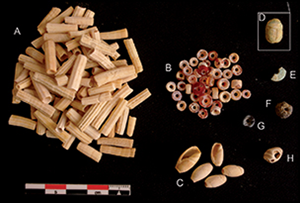Crossref Citations
This article has been cited by the following publications. This list is generated based on data provided by
Crossref.
Groucutt, Huw S
Breeze, Paul S
Guagnin, Maria
Stewart, Mathew
Drake, Nick
Shipton, Ceri
Zahrani, Badr
Omarfi, Abdulaziz Al
Alsharekh, Abdullah M
and
Petraglia, Michael D
2020.
Monumental landscapes of the Holocene humid period in Northern Arabia: The mustatil phenomenon.
The Holocene,
Vol. 30,
Issue. 12,
p.
1767.
Guagnin, Maria
Shipton, Ceri
Martin, Louise
Kingwell-Banham, Eleanor
Breeze, Paul
Graham, Lisa
Ott, Florian
Stewart, Mathew
El-Dossary, Sarah
Zahrani, Badr
Al-Omari, Abdulaziz
Alsharekh, Abdullah M.
and
Petraglia, Michael
2021.
A tale of two hearth sites: Neolithic and intermittent mid to late Holocene occupations in the Jubbah oasis, northern Saudi Arabia.
Archaeological Research in Asia,
Vol. 26,
Issue. ,
p.
100278.
Charloux, Guillaume
AlMalki, Thamer
and
AlQaeed, Ahmed
2021.
The “walled oases” phenomenon. A study of the ramparts in Dūmat al‐Jandal and other pre‐Islamic sites in north‐western Arabia.
Arabian Archaeology and Epigraphy,
Vol. 32,
Issue. S1,
p.
256.
Thomas, Hugh
Kennedy, Melissa A.
Dalton, Matthew
McMahon, Jane
Boyer, David
and
Repper, Rebecca
2021.
The mustatils: cult and monumentality in Neolithic north-western Arabia.
Antiquity,
Vol. 95,
Issue. 381,
p.
605.
Thomas, Hugh
Kennedy, Melissa
McMahon, Jane
Strolin, Laura
Franklin, Daniel
Flavel, Ambika
Noble, Jacqueline
and
Swift, Lauren
2021.
Monumentality, Social Memory, and Territoriality in Neolithic–Chalcolithic Northwestern Arabia.
Journal of Field Archaeology,
Vol. 46,
Issue. 4,
p.
239.
Stewart, Mathew
Andrieux, Eric
Clark-Wilson, Richard
Vanwezer, Nils
Blinkhorn, James
Armitage, Simon J.
al Omari, Abdulaziz
Zahrani, Badr
Alqahtani, Mesfer
Al-Shanti, Mahmoud
Zalmout, Iyad
Al-Mufarreh, Yahya S. A.
Alsharekh, Abdullah M.
Boivin, Nicole
Petraglia, Michael D.
and
Groucutt, Huw S.
2021.
Taphonomy of an excavated striped hyena (Hyaena hyaena) den in Arabia: implications for paleoecology and prehistory.
Archaeological and Anthropological Sciences,
Vol. 13,
Issue. 8,
Fradley, Michael
Simi, Francesca
and
Guagnin, Maria
2022.
Following the herds? A new distribution of hunting kites in Southwest Asia.
The Holocene,
Vol. 32,
Issue. 11,
p.
1160.
Guagnin, Maria
Charloux, Guillaume
AlSharekh, Abdullah M.
Crassard, Rémy
Hilbert, Yamandú H.
Andreae, Meinrat O.
AlAmri, Abdullah
Preusser, Frank
Dubois, Fulbert
Burgos, Franck
Flohr, Pascal
Mora, Pascal
AlQaeed, Ahmad
and
AlAli, Yasser
2022.
Life-sized Neolithic camel sculptures in Arabia: A scientific assessment of the craftsmanship and age of the Camel Site reliefs.
Journal of Archaeological Science: Reports,
Vol. 42,
Issue. ,
p.
103165.
Lidour, Kevin
2023.
Thoughts on Neolithic fishing-based economies in coastal Eastern Arabia.
Journal of Anthropological Archaeology,
Vol. 70,
Issue. ,
p.
101489.
Nassr, Ahmed
Elhassan, Ahmed
Tueaiman, Ali
and
al-Hajj, Mohammed
2023.
Monumental Stone Structure Archaeology in Northwest Saudi Arabia: New Investigations from the Al Ha’it Oasis.
Journal of Eastern Mediterranean Archaeology and Heritage Studies,
Vol. 11,
Issue. 1,
p.
45.
Lucarini, Giulio
Guagnin, Maria
Shipton, Ceri
Radini, Anita
Alsharekh, Abdullah M.
Petraglia, Michael
and
Iovita, Radu
2023.
Plant, pigment, and bone processing in the Neolithic of northern Arabia–New evidence from Use-wear analysis of grinding tools at Jebel Oraf.
PLOS ONE,
Vol. 18,
Issue. 10,
p.
e0291085.
Kennedy, Melissa
Strolin, Laura
McMahon, Jane
Franklin, Daniel
Flavel, Ambika
Noble, Jacqueline
Swift, Lauren
Nassr, Ahmed
Fallon, Stewart
Thomas, Hugh
and
Petraglia, Michael D.
2023.
Cult, herding, and ‘pilgrimage’ in the Late Neolithic of north-west Arabia: Excavations at a mustatil east of AlUla.
PLOS ONE,
Vol. 18,
Issue. 3,
p.
e0281904.
Guagnin, Maria
Shipton, Ceri
Stileman, Finn
Jibreen, Faisal
AlSulaimi, Malek
Breeze, Paul S.
Stewart, Mathew
Hatton, Amy
Drake, Nick
Jha, Deepak Kumar
Al-Tamimi, Fahad
Al-Shamry, Mohammed
Al-Shammari, Mishaal
Kay, Andrea
Groucutt, Huw S.
Alsharekh, Abdullah M.
and
Petraglia, Michael
2023.
Before the Holocene humid period: Life-sized camel engravings and early occupations on the southern edge of the Nefud desert.
Archaeological Research in Asia,
Vol. 36,
Issue. ,
p.
100483.





